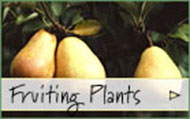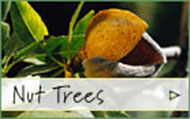|

We offer many different disease resistant apple trees on a variety of rootstocks. Factors affecting eventual size of fruit trees include the natural fertility of the site, fertilizer, age, and variance between individual varieties. For example, some apple varieties are naturally vigorous - William's Pride, Gravenstein, Chehalis, King, Northern Spy, and Spitzenberg or compact such as Liberty, Akane, and Winter Banana.
The advantage of dwarfing rootstocks is in ease of harvest, quick bearing and large fruit. Small trees can be planted much closer together, allowing for greater variety in a small area. One disadvantage of dwarfs are a smaller root systems, resulting in poorer anchoring and more drought susceptibility.
Dwarfing apple trees with heavy fruit loads may need staking or other support to keep from falling over. Early thinning of heavy crop loads can lessen this problem and will increase the size of remaining fruit.
Summer pruning, from June to early August, has a naturally dwarfing effect on dwarfs or standard sizes, keeping them small for ease of harvest and to accommodate smaller spaces. With annual pruning, the apple trees can be maintained short enough to reach from the ground with an arm outstretched. A compact tree is also much easier to net if bird predation is a problem.
Rootstocks: If we're out of a rootstock size for the variety you select, we will substitute the closest size available unless you request no substitutions.
Mini Dwarf - EM27 is our most dwarfing rootstock to about 5 ft. M9 and Bud 9 are more typically 6-10 ft. All are very precocious and require staking or trellising.
Dwarf - EM26 reach 8-12 ft. and can be free standing if thinned when young.
Semi-dwarf - EM7A and M106 are semi-dwarfs that grow 10-17 ft. M111 is a slighter larger semi-dwarf. BUD118 is an extra hardy Russian rootstock, gives a large semi-dwarf tree, about the size of M111. They are all better anchored and more drought tolerant.
Standard - Antonovka is a standard rootstock which gives a very hardy, well anchored, full sized tree (+20 ft.).
THE APPLE VARIETIES ARE LISTED BELOW IN ORDER OF RIPENING
|

 Click here to view items for:
Winter / Spring (Jan-June)
Summer (July-Oct)
Fall (Nov-Dec)
Click here to view items for:
Winter / Spring (Jan-June)
Summer (July-Oct)
Fall (Nov-Dec)
















